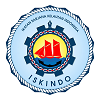The Effect of Ammonium Concentration Addition to Gracilaria sp. on The Absorption of Mercury
Abstract
The research was conducted from March to June 2015 in the laboratory of Marine Science of the faculty of FPIK UNPAD. The sampling of Gracilaria sp. was taken from a seaweed farming in Kalianda, Bandar Lampung Province. The aim of conducting this research is to investigate the effect of Ammonium addition to Gracilaria sp. on the absorption process of Mercury. The proportion amount of 10.5-gram Gracilaria sp. used in this research is mixed with 3 litres seawater media. The research method was performed using Completely Randomised Design (CRD) with four treatments and three replications. Parameters for the measurements are water quality, reduction of mercury and ammonium concentration, bio concentration factor, and growth rate. The research was designed with an addition of 0.05 ppm Mercury in all treatments, where each treatment was given different concentrations of Ammonium as follows: treatment A: 0.5 ppm, treatment B: 1 ppm, and treatment C: 1.5 ppm, with no addition of Ammonium for Control Treatment. The result of this research showed that treatment C hit the highest absorption level in absorbing Ammonium and Mercury with their concentrations of 95.98% and 56.44% respectively in seawater media, while the concentration of Mercury in the Gracilaria sp. biomass was measured 0.47 ppm.
Keywords: Absorption, Ammonium, Gracilaria sp., Phytoremediation, Mercury.
Full Text:
PDFReferences
Bibak, M., Sattari, M., Tahmasebi, S., Agharokh, A., & Namin, J. I. (2020). Marine macro-algae as a bio-indicator of heavy metal pollution in the marine environments, Persian Gulf. Indian Journal of Geo-Marine Sciences, 49(3), 357–363.
Hosseini, M., Nabavi, S. M. B., Parsa, Y., & Saadatmand, M. (2016). Mercury contamination in some marine biota species from Khuzestan shore, Persian Gulf. Toxicology and Industrial Health, 32(7), 1302–1309. https://doi.org/10.1177/0748233714555392
Ihsan, Y. N., Aprodita, A., Rustikawati, I., & Pribadi, T. D. K. (2015). The ability of Gracilaria sp. as a bioremediation agent in absorbing heavy metal Pb. Jurnal Kelautan, 8(1), 10–18.
Ihsan, Y. N., Subiyanto, Pribadi, T. D. K., & Schulz, C. (2019). Nitrogen assimilation potential of seaweed (Gracilaria verrucosa) in polyculture with pacific white shrimp (Penaeus vannamei). AACL Bioflux, 12(1), 51–62.
Khaled, A., Hessein, A., Abdel-Halim, A. M., & Morsy, F. M. (2014). Distribution of heavy metals in seaweeds collected along marsa-matrouh beaches, Egyptian mediterranean sea. Egyptian Journal of Aquatic Research, 40(4), 363–371. https://doi.org/10.1016/j.ejar.2014.11.007
Khangarot, B. S. (1981). Lethal Effects of Zinc and Nickel on Freshwater Teleosts. Acta Hydrochimica et Hydrobiologica, 9(3), 297–302. https://doi.org/10.1002/aheh.19810090308
Macreadie, P. I., Jarvis, J., Trevathan-Tackett, S. M., & Bellgrove, A. (2017). Seagrasses and Macroalgae: Importance, Vulnerability and Impacts. In Climate Change Impacts on Fisheries and Aquaculture (Issue November). https://doi.org/10.1002/9781119154051.ch22
Paz-Alberto, A. M., & Sigua, G. C. (2013). Phytoremediation: A Green Technology to Remove Environmental Pollutants. American Journal of Climate Change, 02(01), 71–86. https://doi.org/10.4236/ajcc.2013.21008
Pribadi, T. D. K., Ihsan, Y. N., Fellatami, K., Syamsuri, R. R. P., & Koswara, B. (2019). Microbial Fuel Cell: Sustainable Approach for Reservoir Eutrophication. Asian Journal of Water, Environment and Pollution, 16(1), 1–8. https://doi.org/10.3233/AJW190001
Serbula, S. M., Kalinovic, T. S., Ilic, A. A., Kalinovic, J. V., & Steharnik, M. M. (2013). Assessment of airborne heavy metal pollution using Pinus spp. and Tilia spp. Aerosol and Air Quality Research, 13(2), 563–573. https://doi.org/10.4209/aaqr.2012.06.0153
Sweet, L. I., & Zelikoff, J. T. (2001). Toxicology and Immunotoxicology of Mercury : Journal of Toxicology and Environmental Health, Part B(4), 161–205.
Walker, C. H., SIbly, R. M., Hopkin, S. P., & Peakall, D. B. (2012). Principles of Ecotoxicology (fourth). CRC Press Taylor & Francis Group.
Yang, Y. F., Fei, X. G., Song, J. M., Hu, H. Y., Wang, G. C., & Chung, I. K. (2006). Growth of Gracilaria lemaneiformis under different cultivation conditions and its effects on nutrient removal in Chinese coastal waters. Aquaculture, 254(1–4), 248–255. https://doi.org/10.1016/j.aquaculture.2005.08.029
Yulianto, B., Pramesti, R., Hamdani, R., Sunaryo, S., & Santoso, A. (2018). Biosorption Capacity and Growth of Seaweed Gracilaria sp. In Media Containing Heavy Metal Cadmium (Cd). Jurnal Kelautan Tropis, 21(2), 129. https://doi.org/10.14710/jkt.v21i2.3849
DOI: https://doi.org/10.21107/jk.v15i1.13447
Refbacks
- There are currently no refbacks.

This work is licensed under a Creative Commons Attribution 4.0 International License.

Jurnal Kelautan by Program Studi Ilmu Kelautan is licensed under a Creative Commons Attribution 4.0 International License.
Published by: Department of Marine Sciences, Trunojoyo University of Madura













